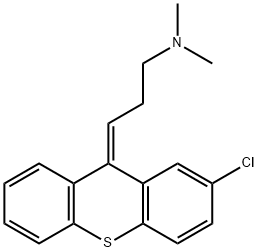In 2002, the American Association of Poison Control Centers’
Toxic Exposure Surveillance System reported 5224 human
exposures to phenothiazines, thioxanthenes, and other neuroleptic
medications; 3691 were in adults and 808 in children.
Unintentional and intentional exposures accounted for 43.7
and 47.8%, respectively. There were 417 (8.0%) adverse drug
reactions reported. Thioxanthenes are chemical compounds in
which the oxygen atom in xanthene is replaced with a sulfur
atom. They are also related to phenothiazines. Several derivatives
are used as typical antipsychotics in the treatment of
schizophrenia and other psychoses. The thioxanthenes, as
a class, are closely related chemically to the phenothiazines. The
major structural difference is that the nitrogen at position 10 in
the phenothiazines is replaced by a carbon atom with a double
bond to the side chain, as shown in the chemical structure of
flupenthixol, which has a double-bonded carbon in the number
10 position. Clopenthixol is a typical antipsychotic drug of the
thioxanthenes class and a racemic mixture of cis and trans
isomers. Zuclopenthixol, the pure cis isomer, has been much
more widely used. Both drugs are equally effective as antipsychotics
and have similar adverse effect profiles, but clopenthixol
is half as active on a milligram-to-milligram basis and appears
to produce more sedation in comparison.

